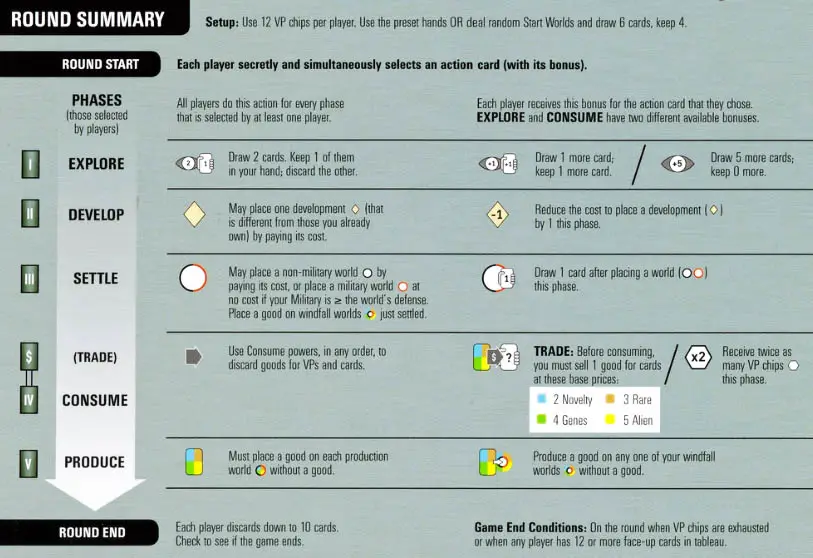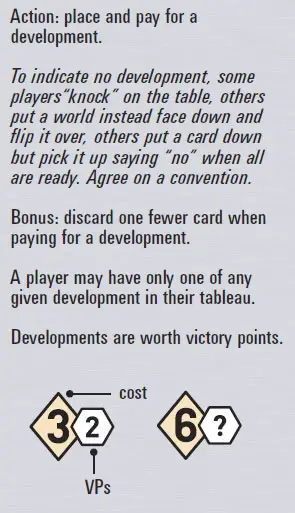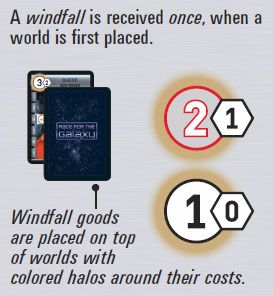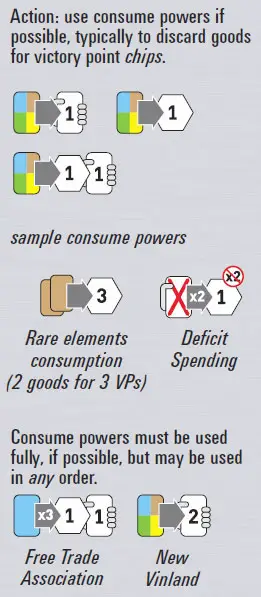

Game Components
- 5 start world cards
- 109 game cards (59 worlds, 50 developments)
- 4 sets of 7 player action cards
- 8 duplicate action cards for experienced 2-player games
- 4 summary sheets
- 28 Victory Point (VP) chips
Setup
Place 12 victory point (VP) chips per player in 1 and 5 VP chips nearby. Set aside the 10 VP chips (and any left over chips) for use only during the final round of play.
Each player takes a set of seven different action cards.
Find and shuffle the five start worlds. Deal one world face up to each player. These form each player's initial card tableau.
Your first game: instead, for two players, use start worlds 1 and 2; for three, use start worlds 1-3; and, for four, use start worlds 1-4.
Shuffle the unused start worlds together with the game cards. Deal six face down cards to each player. Each player then examines these cards and discards two cards face down to the discard pile. The remaining game cards form the initial card supply.
Your first game: instead, each player uses the four numbered game cards matching his start world's number as his initial (preset) hand. After finding these preset hand cards, shuffle all the remaining game cards, including any left over start worlds and preset hand cards, together.
The start worlds, preset hands, and action card sets for your very first game have already been presorted by the printer.
If Alpha Centauri is in play, place a card from the card supply face down on top of it (as its starting windfall good).

Game Play
A game is played over several rounds (typically 7 to 11). At the start of a round, each player simultaneously and secretly chooses one action card, placing it face down in front of himself.
Once all players have done so, they turn these action cards face up. Then, the players perform the selected phases in order (I: Explore; II: Develop; III: Settle; IV: Consume; V: Produce), omitting every phase not chosen by at least one player.
Each phase has an action, which is performed by all players. In addition, the players who chose that phase get a bonus.
Important: if more than one player chooses the same phase, its action is still only performed once (with all the players who selected that phase receiving a bonus).
The bonus for an action either modifies it (such as reducing its cost or doubling the VPs gained) or is in addition to it (such as a card draw afterwards or the opportunity to sell a good).
Players may find it useful to turn over the action card(s) for each phase as it is completed before performing the next one.
New players may find it useful to place the selected action cards in the center in numerical order. As players become more familiar with the phase order, this won't be necessary.
After all phases chosen that round have been performed, each player must discard down to ten (game) cards in his hand and then reclaims the action card that he or she played that round.
Successive rounds are performed in the same manner until an end-of-game condition is met (see Game End below).
Game cards have three uses: as a development or world to be placed in a player's tableau; as one wealth to discard from one's hand face down when paying to place a development or world; or as a good placed face down on a world either upon it being settled or during production.

I. Explore
Action: each player draws two cards and then simultaneously selects which one of them to add to his hand, discarding the other card face down in the center discard area.
All cards drawn are dealt out before any cards are discarded. There are two possible Explore bonuses, depending on which Explore action card was chosen by a player.
A player who chose Explore: +5 draws five more cards to select from before making his choice. Such a player explores by drawing 7 cards and choosing 1 of them to add to his hand.
A player who chose Explore: +1,+1 draws one more card to select from and keeps another card. Such a player explores by drawing 3 cards and choosing 2 of them to add to his hand.
Thus, depending on the bonus chosen with the Explore action, a player can either have more cards to select from or gain an extra card to keep. The powers of various cards can alter these rules if a player has them in his tableau, possibly providing extra card draws or allowing a player to keep additional cards.
II. Develop

Action: each player places a development card from his hand face down, or no card if a player doesn't intend to place a development. Once all players have done so, they simultaneously turn them face up and then pay for them. If desired, players can put their intended developments (if any) under their action card, revealing them when everyone is ready.
Each development has a symbol containing its cost, ranging from 1-6. To pay for a development, a player discards cards equal to this number face down from his hand. Players who chose Develop, as the bonus, discard one card fewer than the development's cost.
If, due to special powers, a player is already discarding no cards, no bonus is received. A player may not build a given development if another copy of it is currently in his tableau.
Next to a development's diamond is its victory point (VP) value. It adds to the player's final victory point total at the end of the game. 6-cost developments have listed as their victory point values. These are worth a variable number of victory points at the end of the game, as indicated on these cards. The powers of various cards can alter these rules if a player has them in his tableau before the development phase begins.
Card Powers
Every development, and most worlds, list one or more powers. Standard powers are depicted by icons with no text description (see the reference sheet). Special powers have icons, highlighted phases, and text descriptions at the bottom of the card which begin with the corresponding phase number. All powers modify rules and are cumulative. A power modifies only the rules listed in its description; all other rules still apply.
"Draw" - in all phases except Explore - means draw a card and add it to your hand. In Explore, it means draw a card and add it to the cards you then select from, as in the Explore rules.
If, due to powers, a cost is reduced below 0, it becomes 0. A player does not receive cards as a "refund" if this occurs.
A power does not take effect in the phase in which its card is placed; it can begin to take effect as soon as the next phase. Thus, the Public Works power to draw one card after its owner builds a development does not apply to Public Works itself. Unless a power's description uses the word "may", a power must be used, if possible, in the phase to which it applies (though a player may freely choose the order in which to invoke powers, as discussed further under Consume).
An optional power (such as a Colony Ship) must be used if it is needed to place a development or world which a player has selected and then revealed. Powers are resolved sequentially (even though their effects can be cumulative). A player cannot "interrupt" one power with another.
III. Settle
Action: each player places a world card from his hand face down, or no card if a player doesn't intend to place a world. Once all players have done so, they simultaneously turn them face up and then pay for (or conquer) them. Many worlds contain a black number, ranging from 0-6, in a black circle; this is the world's cost. To pay for such worlds, the player discards cards face down from his hand equal to this number.
Players who chose Settle, as the bonus, draw one card after placing and paying for (or conquering) a world. Beside a world's circle is its victory point value. This adds to the player's final victory point total at the end of the game.
The powers of various cards can alter the settle rules if a player has them in his tableau before the settle phase begins.

Windfalls: some worlds have a colored "halo" around their circle, showing that they are windfall worlds and that a good is to be put on them when they are first settled.
To do so, as part of placing the world in a player's tableau, he takes a card face down - without looking at it - from the card supply and puts it on top of the world's lower right portion (to avoid hiding the world's VPs and powers). This card represents a good of the kind indicated by the color of the world's halo.
There are four kinds of goods in the game:
- Alien technology , artifacts left by the vanished Alien Overlords.
- Genes , genetic material used in biological research.
- Rare elements , transuranic elements powering JumpDrive.
- Novelty goods , such as artwork and entertainment.

Military Conquest: some worlds have red circles and, within them, a red outlined number, ranging from 1-7; this is the world's defense. These worlds cannot be placed by payment, but instead must be conquered. To conquer a world, a player's total Military must equal or exceed the world's defense. Then, the player simply places it - and its windfall good, if it has a halo - without paying for it (and then draws a bonus card if that player chose Settle).
Military is granted by powers of various start worlds, developments, or worlds, and lasts until the end of the settle phase. Some developments and worlds, such as the Empath World, subtract from a player's total Military. New Military Tactics may be discarded from a player's tableau for +3 Military until the end of that settle phase.
A Contact Specialist enables a player to place and pay for a military world (except an Alien military world), at a cost equal to one less than the world's defense.
Important: this cost is not reduced by a player's Military (Military and payments never combine).
Cost discounts from Replicant Robots, Mining Robots, etc. do combine with a Contact Specialist to reduce the cost of placing a military world. Similarly, a Colony Ship allows a Contact Specialist to place a (non-Alien) military world at no cost. Thus, there are two completely separate ways to place military worlds.
IV: Consume

Action: all players must use their consume powers to discard goods for victory point chips and/or card draws.
Some powers consume several goods. Others consume goods of a specific kind. Some, such as Deficit Spending, consume cards, not goods, discarded from a player's hand. A few powers, such as New Economy, don't involve discarding anything; they simply take effect during a Consume phase.
Goods are discarded face down (without examining them). Each good being discarded applies to only one consume power. A good may or may not be on the world consuming it.
Consumption is mandatory. However, consume powers can be invoked in any desired order, even if this results in some unconsumed goods left over that could have been consumed with a different order (due to their kinds not matching the player's remaining unused consume powers). Each consume power can be used only once in a consume phase. Some powers allow multiple goods, "up to" some number, to be discarded, with each good producing an effect. Such powers must be fully used, if possible, when invoked.
Thus, a player with a tableau containing three novelty goods, New Vinland, and Free Trade Association, cannot consume two goods using FTA's power (to consume up to 3 novelty goods for 1 VP and a card apiece) and then, based on the cards received, decide to consume the third novelty good using New Vinland's power (to consume a good for two cards). The third novelty good must now be consumed by FTA. (These powers could have been invoked in the reverse order, but this choice must be made before invoking FTA's power - once a power is invoked, its resolution cannot be interrupted by another power).
There are two possible Consume bonuses, depending on which Consume action card was chosen by a player.
$: Trade: players who chose Consume: Trade must sell one good (before applying their consume powers), by discarding it and drawing a number of cards that depends on the kind of good sold: Alien technology: 5 cards; Genes: 4 cards; Rare elements: 3 cards; or Novelty: 2 cards. Only players who chose Consume: Trade can sell a good.
Players choosing Consume: Trade also apply all relevant Trade special powers (listed next to $) to this sale (typically, to draw extra cards). Players who chose Consume: 2x VPs double the number of victory point chips - but not any other effects - that their consume powers provide.
Exception: VPs for discarding cards from your hand (from powers such as Deficit Spending or Merchant World) are not doubled by this bonus.
V. Produce

Action: place a good on each production world (worlds with colored, solid circles) without a good, by taking a card face down - without looking at it - from the card supply and putting it on top of the world's lower right portion (to avoid hiding the world's VPs and powers). This good is of the kind indicated by the color of the world's solid circle.
No world can have more than one good. Place a good on the lower right portion of a world to avoid hiding the world's VPs or powers. Some worlds, such as Gem World, provide a card draw as part of producing a good. If a good is already present, then no cards are drawn.
Players who chose Produce, as the bonus, produce a good (if possible) on one of their windfall worlds that does not already have a good.
Some cards, such as Genetics Lab, can also produce goods on windfall worlds (without goods). Others, such as the Pan-Galactic League, provide a card draw for each world of a specific kind in a player's tableau (such as Genes worlds, with either a green halo or a green solid circle).
Round End, Cards and Chips
After all chosen phases are done, players must discard down to 10 (game) cards before starting the next round.
All discards are face down. Keep the discard pile a bit "messy" so that it is not confused with the card supply.
When the card supply is exhausted, immediately reshuffle the discards to form a new card supply.
All players' VP chips and the number of game cards they have in their hands are open for examination. Make change among VP chips as needed.
End of the game

The game ends at the end of the round (including discarding) in which:
- player has 12 or more cards in his card tableau, or (A player can end with more than 12 cards in his card tableau by placing both a development and a world in the final round).
- the last victory point chip is given out.
If victory point chips run out, add the 10 VP chips and make change so that all victory points earned in the final consume phase can be taken.
Total each players development and world VPs, VP chips, and any end of game VPs for 6-cost developments.
The player with the highest total is the winner.
If two or more players tie, the player among them with the highest total number of cards in hand (after discarding) and goods on worlds wins.
If there is still a tie, then all the tied players win.
Continue Reading


